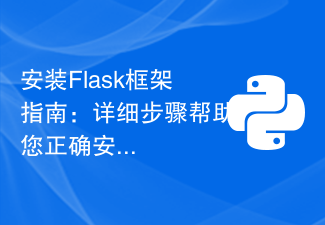
Decrypt the mystery of package storage installed by pip
With the increasing popularity and widespread application of the Python language, pip as a Python package management tool is becoming more and more popular among developers. popular. Through pip, developers can easily search, install and manage Python packages. However, the mystery of pip-installed package storage remains a mystery to some novice developers.
This article will give you an in-depth understanding of how pip installation packages are stored and the corresponding decryption methods. Through specific code examples, you will better understand how pip packages are installed and stored.
First, we need to understand the default location where pip stores packages. In most cases, pip will store installed packages in the site-packages folder of your Python environment. The location of this folder depends on how Python was installed and the operating system. Generally speaking, on Windows systems, the site-packages folder path is similar to: "C:PythonPython39Libsite-packages", while on Linux systems, it is similar to: "/usr/local/lib/python3.9/site-packages ".
Next, we will enter specific code examples to explore the secrets of pip package storage.
First, let us use pip to install a commonly used package, such as numpy.
pip install numpy
After the installation is completed, we can find the relevant files of the numpy installation package in the site-packages folder. Please note that the specific file names and paths to these files may vary depending on your operating system and Python version.
Next, let us import the numpy package in the Python script and print its file path to understand where the pip package is stored.
import numpy print(numpy.__file__)
Run the above code, you will get output similar to the following:
C:PythonPython39Libsite-packages umpy__init__.py
This indicates that the numpy package is successfully installed into the numpy subfolder in the site-packages folder.
Now that we have understood the storage location of the pip package, next, we will decrypt the storage format of the pip package.
Open the site-packages folder, you will see that each package has a folder named after the package name, such as numpy. In the numpy folder, you can find various files and folders related to the package, including __init__.py files, module files, library files, etc.
In addition, you can also find a folder named metadata in the site-packages folder. This folder contains metadata information about installed packages, such as package name, version number, author, etc. This information is used by pip when installing, upgrading and uninstalling packages.
Through the above decryption process, we have a deeper understanding of the package storage method installed by pip. We know that pip stores packages in the site-packages folder by default, and uses the package name as the folder name. In addition, we also know that the metadata folder holds metadata information about installed packages.
With this knowledge, developers can better understand the installation and storage process of pip packages, and can perform package management and development work more effectively.
To sum up, pip, as an important tool for Python, provides developers with convenient package management functions. Although the mystery of pip-installed package storage may be a mystery to some novices, by gaining a deeper understanding of where and what format pip packages are stored, as well as using concrete code examples, we are better able to decipher how pip packages are stored. I hope this article can bring you some useful knowledge and inspiration, making you more comfortable in Python development.
The above is the detailed content of Revealing the secrets hidden in the pip installation package. For more information, please follow other related articles on the PHP Chinese website!
 解决pip安装缓慢问题,试试这个pip国内源教程Jan 17, 2024 am 09:13 AM
解决pip安装缓慢问题,试试这个pip国内源教程Jan 17, 2024 am 09:13 AM遇到pip安装慢?试试这个pip国内源教程,需要具体代码示例概述:在使用Python进行开发的过程中,我们经常会使用pip命令来安装各种依赖包。然而,由于众所周知的原因,国外的pip源有时候会变得非常慢,甚至无法连接。针对这个问题,我们可以使用国内的pip源来加快下载速度。本文将介绍如何配置国内的pip源,并给出具体的代码示例。步骤一:备份原有源文件在开始配
 简单使用pip安装whl文件的步骤Jan 04, 2024 pm 01:04 PM
简单使用pip安装whl文件的步骤Jan 04, 2024 pm 01:04 PM如何使用pip轻松安装whl文件在Python开发中,我们经常会使用到各种第三方库来提供额外的功能支持。而pip作为Python的包管理工具,能够快速安装和管理这些第三方库。通常我们使用pip来安装库时,是通过执行pipinstall命令加上库名来进行安装的。不过有些时候,我们会遇到一种特殊的情况:需要安装一个.whl文件而不是常规的.py文件。那么如何使
 加快pip下载速度的方法Feb 02, 2024 pm 12:03 PM
加快pip下载速度的方法Feb 02, 2024 pm 12:03 PM如何解决pip下载速度慢的问题引言:在使用Python进行开发时,我们经常会使用到pip工具来安装各种第三方模块。然而,有时候我们会遇到pip下载速度慢的问题,这会给我们的开发工作带来一些困扰。本文将介绍一些解决pip下载速度慢问题的方法,并给出具体的代码示例,帮助读者更好地解决这个问题。一、更换pip源pip默认会使用官方的源来下载模块,但是由于网络环境的
 解决常见的pandas安装问题:安装错误的解读和解决方法Feb 19, 2024 am 09:19 AM
解决常见的pandas安装问题:安装错误的解读和解决方法Feb 19, 2024 am 09:19 AMpandas安装教程:解析常见安装错误及其解决方法,需要具体代码示例引言:Pandas是一个强大的数据分析工具,广泛应用于数据清洗、数据处理和数据可视化等方面,因此在数据科学领域备受推崇。然而,由于环境配置和依赖问题,安装pandas可能会遇到一些困难和错误。本文将为大家提供一份pandas安装教程,并解析一些常见的安装错误及其解决方法。一、安装pandas
 7大Linux GPU监控和诊断命令行工具Feb 11, 2024 pm 08:48 PM
7大Linux GPU监控和诊断命令行工具Feb 11, 2024 pm 08:48 PM视频卡是一种特殊的电路板,用于控制计算机监视器上显示的内容。它也称为图形处理单元(GPU),可为Linux游戏和其他用途计算3D图像和图形。让我们看一下解决问题的7大LinuxGPU监视和诊断命令行工具。以下工具在Linux上可用于GPU监视和诊断目的,以及其他操作系统(例如FreeBSD)上运行。如今,大多数Linux和FreeBSD用户都使用Nvidia,Intel和AMDGPU。LinuxGPU监控和诊断命令行工具我们可以使用以下工具来监视、诊断和检查基于Linux或*BSD的系统。获得图
 了解pip安装包存储的位置和结构Jan 18, 2024 am 08:23 AM
了解pip安装包存储的位置和结构Jan 18, 2024 am 08:23 AM深入了解pip安装的包存放位置,需要具体代码示例pip是Python语言常用的包管理工具,用于方便地安装、升级和管理Python包。在使用pip安装包时,它会自动从PyPI(Python包索引)下载对应的包文件,并将其安装到指定的位置。那么,pip安装的包究竟存放在哪里呢?这是很多Python开发者都会遇到的问题。本文将深入探讨pip安装的包存放位置,并提供
 安装Flask框架指南:详细步骤帮助您正确安装FlaskFeb 18, 2024 pm 10:51 PM
安装Flask框架指南:详细步骤帮助您正确安装FlaskFeb 18, 2024 pm 10:51 PMFlask框架安装教程:一步步教你如何正确安装Flask框架,需要具体代码示例引言:Flask是一款简洁而灵活的PythonWeb开发框架。它易于学习、易于使用,并且具有强大的功能。本文将带领您一步步正确地安装Flask框架,并提供详细的代码示例供参考。第一步:安装Python在安装Flask框架之前,首先需要确保您的计算机上安装了Python。您可以从P
 安装和解决Scipy库常见错误指南Feb 18, 2024 am 10:53 AM
安装和解决Scipy库常见错误指南Feb 18, 2024 am 10:53 AMScipy库安装指南及常见错误解决办法引言:Scipy是一个Python科学计算的开源库,提供了丰富的数学、科学和工程计算功能。它建立在NumPy库的基础之上,能够处理一些复杂的数值计算问题。本文将介绍Scipy的安装指南,并提供一些常见的错误解决办法,并配有具体的代码示例,帮助读者更好地理解和使用Scipy。一、Scipy库的安装指南安装Python和pi


Hot AI Tools

Undresser.AI Undress
AI-powered app for creating realistic nude photos

AI Clothes Remover
Online AI tool for removing clothes from photos.

Undress AI Tool
Undress images for free

Clothoff.io
AI clothes remover

AI Hentai Generator
Generate AI Hentai for free.

Hot Article

Hot Tools

SAP NetWeaver Server Adapter for Eclipse
Integrate Eclipse with SAP NetWeaver application server.

Dreamweaver Mac version
Visual web development tools

SecLists
SecLists is the ultimate security tester's companion. It is a collection of various types of lists that are frequently used during security assessments, all in one place. SecLists helps make security testing more efficient and productive by conveniently providing all the lists a security tester might need. List types include usernames, passwords, URLs, fuzzing payloads, sensitive data patterns, web shells, and more. The tester can simply pull this repository onto a new test machine and he will have access to every type of list he needs.

SublimeText3 Linux new version
SublimeText3 Linux latest version

EditPlus Chinese cracked version
Small size, syntax highlighting, does not support code prompt function





